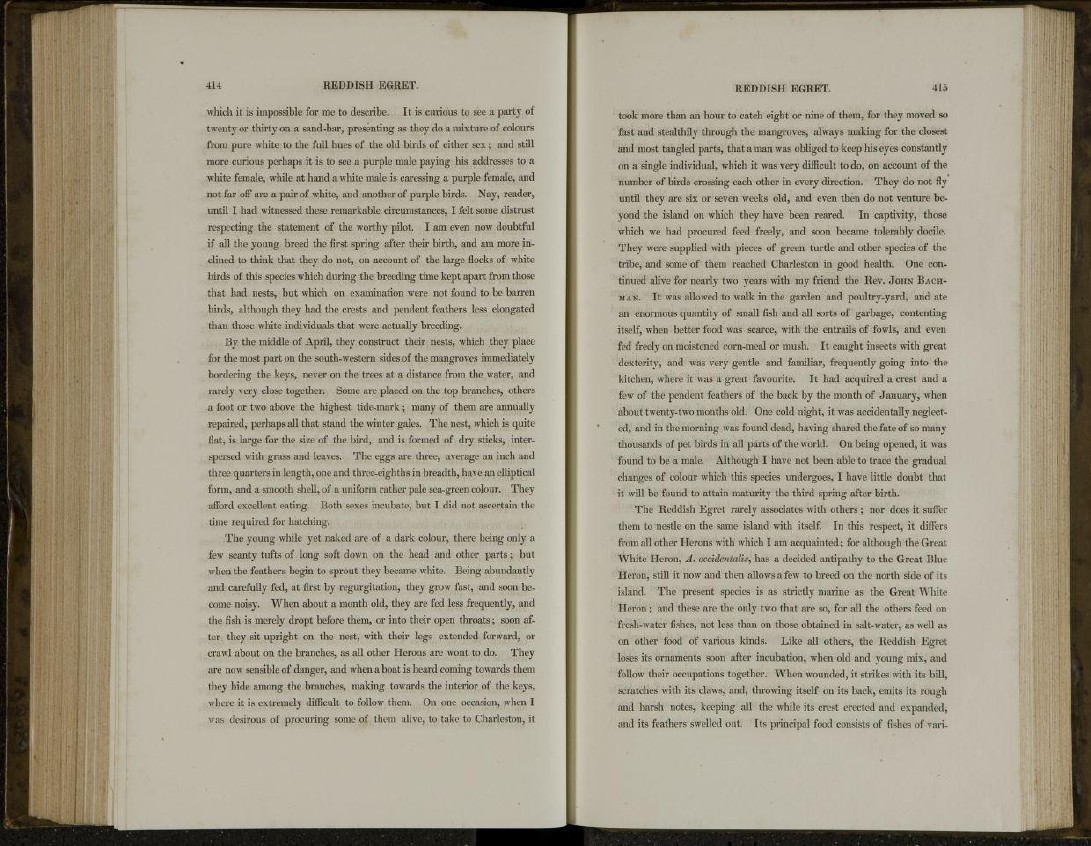
which it is impossible for me to describe. It is curious to see a party of
twenty or thirty on a sand-bar, presenting as they do a mixture of colours
from pure white to the full hues of the old birds of either sex; and still
more curious perhaps it is to see a purple male paying his addresses to a
white female, while at hand a white male is caressing a purple female, and
not far off are a pair of white, and another of purple birds. Nay, reader,
until I had witnessed these remarkable circumstances, I felt some distrust
respecting the statement of the worthy pilot. I am even now doubtful
if all the young breed the first spring after their birth, and am more inclined
to think that they do not, on account of the large flocks of white
birds of this species which during the breeding time kept apart from those
that had nests, but which on examination were not found to be barren
birds, although they had the crests and pendent feathers less elongated
than those white individuals that were actually breeding.
By the middle of April, they construct their nests, which they place
for the most part on the south-western sides of the mangroves immediately
bordering the keys, never on the trees at a distance from the water, and
rarely very close together. Some are placed on the top branches, others
a foot or two above the highest tide-mark ; many of them are annually
repaired, perhaps all that stand the winter gales. The nest, which is quite
flat, is large for the size of the bird, and is formed of dry sticks, interspersed
with grass and leaves. The eggs are three, average an inch and
three quarters in length, one and three-eighths in breadth, have an elliptical
form, and a smooth shell, of a uniform rather pale sea-green colour. They
afford excellent eating. Both sexes incubate, but I did not ascertain the
time required for hatching.
The young while yet naked are of a dark colour, there being only a
few scanty tufts of long soft down on the head and other parts; but
when the feathers begin to sprout they became white. Being abundantly
and carefully fed, at first by regurgitation, they grow fast, and soon become
noisy. When about a month old, they are fed less frequently, and
the fish is merely dropt before them, or into their open throats; soon after
they sit upright on the nest, with their legs extended forward, or
crawl about on the branches, as all other Herons are wont to do. They
are now sensible of danger, and when a boat is heard coming towards them
they hide among the branches, making towards the interior of the keys,
where it is extremely difficult to follow them. On one occasion, when I
was desirous of procuring some of them alive, to take to Charleston, it
took more than an hour to catch eight or nine of them, for they moved so
fast and stealthily through the mangroves, always making for the closest
and most tangled parts, that a man was obliged to keep his eyes constantly
on a single individual, which it was very difficult to do, on account of the
number of birds crossing each other in every direction. They do not fly
until they are six or seven weeks old, and even then do not venture beyond
the island on which they have been reared. In captivity, those
which we had procured feed freely, and soon became tolerably docile.
They were supplied with pieces of green turtle and other species of the
tribe, and some of them reached Charleston in good health. One continued
alive for nearly two years with my friend the Rev. JOHN BACHMAN.
It was allowed to walk in the garden and poultry-yard, and ate
an enormous quantity of small fish and all sorts of garbage, contenting
itself, when better food was scarce, with the entrails of fowls, and even
fed freely on moistened corn-meal or mush. It caught insects with great
dexterity, and was very gentle and familiar, frequently going into the
kitchen, where it was a great favourite. It had acquired a crest and a
few of the pendent feathers of the back by the month of January, when
about twenty-two months old. One cold night, it was accidentally neglected,
and in the morning was found dead, having shared the fate of so many
thousands of pet birds in all parts of the world. On being opened, it was
found to be a male. Although I have not been able to trace the gradual
changes of colour which this species undergoes, I have little doubt that
it will be found to attain maturity the third spring after birth.
The Reddish Egret rarely associates with others ; nor does it suffer
them to nestle on the same island with itself. In this respect, it differs
from all other Herons with which I am acquainted; for although the Great
White Heron, A . occidentalism has a decided antipathy to the Great Blue
Heron, still it now and then allows a few to breed on the north side of its
island. The present species is as strictly marine as the Great White
Heron; and these are the only two that are so, for all the others feed on
fresh-water fishes, not less than on those obtained in salt-water, as well as
on other food of various kinds. Like all others, the Reddish Egret
loses its ornaments soon after incubation, when old and young mix, and
follow their occupations together. When wounded, it strikes with its bill,
scratches with its claws, and, throwing itself on its back, emits its rough
and harsh notes, keeping all the while its crest erected and expanded,
and its feathers swelled out. Its principal food consists of fishes of van